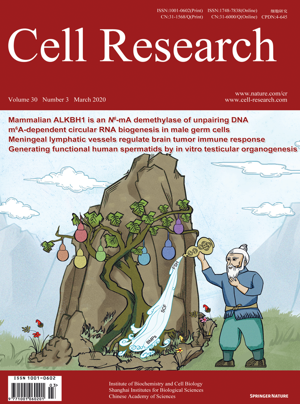
Advanced Search
Submit Manuscript
Advanced Search
Submit Manuscript
Volume 30, No 3, Mar 2020
ISSN: 1001-0602
EISSN: 1748-7838 2018
impact factor 17.848*
(Clarivate Analytics, 2019)
Volume 30 Issue 3, March 2020: 256-268 |
Refined spatial temporal epigenomic profiling reveals intrinsic connection between PRDM9-mediated H3K4me3 and the fate of double-stranded breaks
Yao Chen1, Ruitu Lyu2, Bowen Rong2, Yuxuan Zheng 3,4,5, Zhen Lin1,Ruofei Dai2, Xi Zhang1, Nannan Xie1, Siqing Wang2,Fuchou Tang 3,4,5, Fei Lan2 and Ming-Han Tong1
1State Key Laboratory of Molecular Biology, Shanghai Key Laboratory of Molecular Andrology, CAS Center for Excellence in Molecular Cell Science, Shanghai Institute of Biochemistry and Cell Biology, Chinese Academy of Sciences, University of Chinese Academy of Sciences, Shanghai 200031, China; 2Shanghai Key Laboratory of Medical Epigenetics, International Co-laboratory of Medical Epigenetics and Metabolism, Ministry of Science and Technology, Institutes of Biomedical Sciences, Fudan University, and Key Laboratory of Carcinogenesis and Cancer Invasion, Ministry of Education, Liver Cancer Institute, Zhongshan Hospital, Fudan University, Shanghai 200032, China; 3Beijing Advanced Innovation Center for Genomics, Biomedical Institute for Pioneering Investigation via Convergence, College of Life Sciences, Peking University, Beijing 100871, China; 4Ministry of Education Key Laboratory of Cell Proliferation and Differentiation, Beijing 100871, China and 5Peking-Tsinghua Center for Life Sciences, Peking University, Beijing 100871, ChinaMeiotic recombination is initiated by the formation of double-strand breaks (DSBs), which are repaired as either crossovers (COs) or noncrossovers (NCOs). In most mammals, PRDM9-mediated H3K4me3 controls the nonrandom distribution of DSBs; however, both the timing and mechanism of DSB fate control remain largely undetermined. Here, we generated comprehensive epigenomic profiles of synchronized mouse spermatogenic cells during meiotic prophase I, revealing spatiotemporal and functional relationships between epigenetic factors and meiotic recombination. We find that PRDM9-mediated H3K4me3 at DSB hotspots, coinciding with H3K27ac and H3K36me3, is intimately connected with the fate of the DSB. Our data suggest that the fate decision is likely made at the time of DSB formation: earlier formed DSBs occupy more open chromatins and are much more competent to proceed to a CO fate. Our work highlights an intrinsic connection between PRDM9-mediated H3K4me3 and the fate decision of DSBs, and provides new insight into the control of CO homeostasis.
https://doi.org/10.1038/s41422-020-0281-1